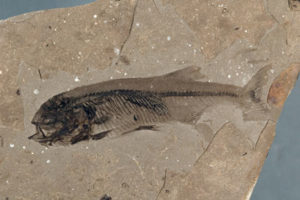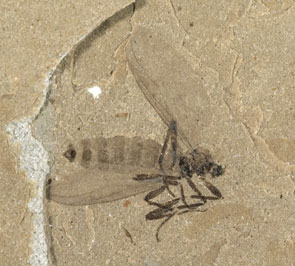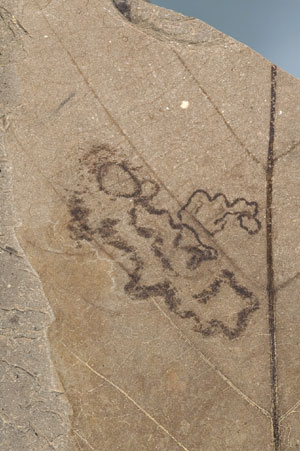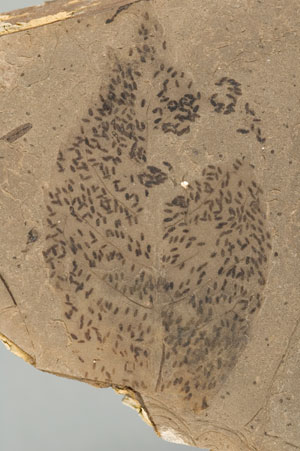Fish and Insect Fossils from the McAbee Deposit
In addition to plant fossils, fish and insect fossils are relatively abundant at the McAbee site. These fossils are often well preserved and provide valuable information about some of the inhabitants of the lake ecosystem.
The fish fossils at McAbee have been previously studied and described by Dr. MarkV.H. Wilson (see reference at the end of this article). The majority of the fish fossils are represented by a single species has been found in the lake deposit. Eohiodon rosei is an extinct relative of the modern mooneyes that survive in North America east of the Rocky Mountains. They are typically about 7.5 cm (3 inches) in length. At least two species of Eohiodon fossils have been found from several of the Okanogan Highland fossil localities, as well as the Eocene Clarno Formation of Oregon, the Eocene Green River Formation of Wyoming and in Oligocene deposits of Montana (Wilson, 1977). Rare partial specimens of a larger fish species have also been found at McAbee, but these have not been identified or described as of yet.
Insect fossils are relatively abundant and represent a very diverse range of types. Bruce Archibald, a PhD candidate at Harvard University, is currently studying the insect fossils from McAbee and other similarly aged localities. Insects commonly found at McAbee include flies, plant hoppers, beetles, and wasps. Rare fossils of many other insect types are found, and further studies should provide important information on the insects in the Eocene of western North America. Figure 2 above shows a spectacular fossil cicada from McAbee that is in the collection at the University College of the Cariboo in Kamloops, B.C.
Many of the leaf fossils also show evidence of insect activity, such as feeding, plant parasitism, and egg laying activities. A couple of examples are shown below. The photo on the left shows a serpentine mine on a beech leaf caused by insect feeding, and the leaf on the right shows possible egg-laying activities. Similar egg scars on leaves from Republic, Washington have been attributed to flea beetles (Lewis, 1992).
Resources
Wilson, M. V. H. 1977. Middle Eocene freshwater fishes from British Columbia. Life Sciences Contributions, Royal Ontario Museum, 113:1-61.
Lewis, S.E. 1992. Insects of the Klondike Mountain Formation, Republic, Washington. Washington Geology, Vol. 20 No. 3: 15-19.






